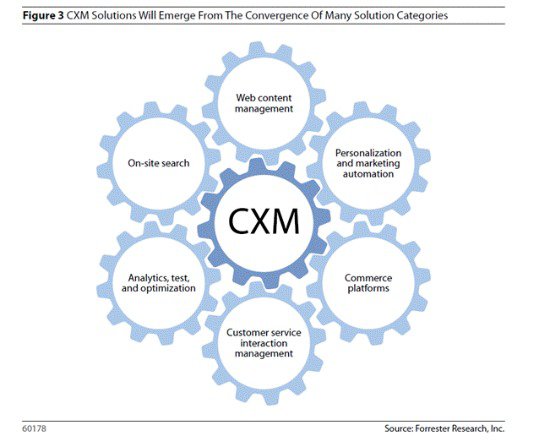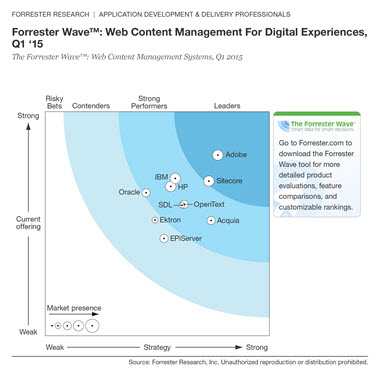In the market for a customer experience management solution? Beware: with the increasing attention for customer experience, not all customer experience management software is what it seems or claims to be.
Many customer feedback solutions and quite some CRM, marketing automation and Enterprise Content Management system (ECM) cloud solution vendors call themselves providers of customer experience management software these days, even if they’re not really always that.
But then again, many CEM solution vendors have risen from a convergence of various solution categories as Forrester Research predicted back in 2011 (with a focus on the digital evolutions). A simple look at some of the major players says enough. Typical examples: SDL Tridion and OpenText with their roots in content.
Forrester Research still has a Forrester Wave™ on Web Content Management For Digital Experiences and another one for Digital Experience Delivery Platforms. To quote one of the players in the latter category, Hybris (SAP), ‘It’s time for organizations to re-evaluate their existing customer journey and move towards fully integrated digital customer engagement’.

Customer experience management (CEM or sometimes CXM) involves many things and customer feedback, for instance, is just part of a bigger puzzle of truly understanding the customer – to act. Furthermore, depending on their ‘roots’ some customer experience management vendors will focus more on specific aspects of that bigger puzzle than the bigger enterprise CEM/CXM suites or recent players on the market.
Customer experience management solutions: a market in evolution
Sometimes smaller and more specific solutions will fit your need but if you’re really in the market for a state-of-the-art customer experience management solution in this rapidly evolving space where the essential role of customer experience for your business success simply can’t be overlooked anymore you might need several applications that all together help you improve customer experience.

Few solutions offer it all. It’s not a coincidence that Genesys, a big leading player in the contact center market who are changing their narrative with ever more focus on customer experience, announced a marketplace called AppFoundry in the Fall of 2015. Or think about the consolidation in the market whereby CEM vendors acquire niche players with capacities they don’t have – or don’t have enough – in some growth areas. Example: in the Summer of 2015 customer experience management software vendor Clarabridge acquired social media and social customer service expert Engagor.
This consolidation and, as the Genesys app marketplace indicates, ‘partnership integration’ evolution will continue as ever more essential parts of the overall customer experience management equation become more important. Artificial intelligence and text analytics are moving into the realm of customer service and customer experience management (most larger customer experience management vendors offer text analytics). Customer journey mapping platforms sometimes have an approach that beats the functionalities of ‘large’ integrated players. And then there is of course (big, fast, actionable, smart) data and data analytics. The list goes on.
Selecting a customer experience management software: considerations before you start
As in all customer-facing software and, in this connected day and age, really in all business applications, better integration and connectivity in function of the outcome is the name of the game as it always has been across various industries and business functions.
And just as is the case with any software whatsoever your journey should start with one seemingly simple question: what do we need in order to be as successful as possible, depending on our goals and those of our customers and given our individual context?
It’s a hard question to answer really. But you have no choice. And the good news: if you’re in the market for a customer experience management solution without having thought about this we just saved you money. And even better: responding that question forces you to really map everything, including the reality and future of your business.
People, processes, purpose, context, customer and technology/systems. The latter always comes last.
On top of the traditional considerations to take into account when buying any business software, make sure you involve all stakeholders in the customer experience management process and selection process.
Analytics, data collection and mining, customer journey and touchpoint mapping, CRM integration, CX strategy design features, Voice of the Customer tools and analytics, feedback management, support of all customer interaction channels (or the integration with tools to achieve so), the ability to meet functional requirements, IT aspects such as architecture and legacy, ease-of-use, reporting capabilities and TCO all matter. Yet what you need depends on that crucial question to ask.
And as customer experience management is about an ever evolving customer and is gaining importance across various business functions with an avalanche of technologies and integrations (even if it’s about experiences and emotions, let’s not forget that) coming in, make sure any platform can evolve with these realities and with a future roadmap in mind.

